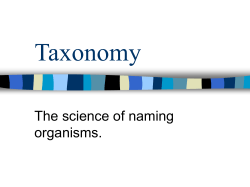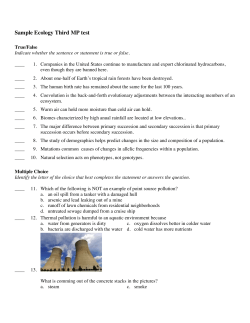
Worksheet 12.3-12.6 Chapter 12.4: Early Single
Worksheet 12.3-12.6 Chapter 12.4: Early Single-Cell Organisms Single-celled organisms existed 3.8 billion years ago. Microbes have changed the physical and chemical composition of Earth. 1. What are two ways that early single-celled organisms changed Earth’s surface? __________________________________________________________________________________________________ __________________________________________________________________________________________________ __________________________________________________________________________________________________ 2. What have scientists inferred from fossil stromatolites? __________________________________________________________________________________________________ __________________________________________________________________________________________________ __________________________________________________________________________________________________ Fill in the blanks with the correct terms. 3. Although prokaryotes existed as long as 3.5 billion years ago, __________ arose about 1.5 billion years ago. 4. Eukaryotes have a __________ and membrane-bound organelles. 5. Eukaryotes are _____________, which means they need oxygen to survive. 6. While the first eukaryotes were made of only one __________, later eukaryotes were made of many 7. Look at page 373 in the textbook, and use the sequence diagram below to summarize the theory of endosymbiosis 8. What important events occurred during the Paleozoic era? __________________________________________________________________________________________________ __________________________________________________________________________________________________ 9. What were some of the key appearances and radiations in the Mesozoic era? __________________________________________________________________________________________________ __________________________________________________________________________________________________ Describe the role that cyanobacteria play in Earth’s early development 13. What is the main advantage of asexual reproduction? __________________________________________________________________________________________________ __________________________________________________________________________________________________ 14. Sexual reproduction increases genetic variation in a population. Why might this be beneficial to the population? __________________________________________________________________________________________________ __________________________________________________________________________________________________ 15. Bacteria that can carry out photosynthesis are called ________________ . 16. How do you think the evolution of flowering plants affected the evolution and radiation of birds? __________________________________________________________________________________________________ __________________________________________________________________________________________________ 17. The mutually beneficial relationship in which one organism lives within the body of another is called . __________________________________________________________________________________________________ __________________________________________________________________________________________________ Chapter 12.5: Radiation of Multicellular Life 1. How does a great diversity of organisms increase the chances that some will survive a major change in the environment? __________________________________________________________________________________________________ __________________________________________________________________________________________________ 2. How do you think the evolution of flowering plants affected the evolution and radiation of birds? __________________________________________________________________________________________________ __________________________________________________________________________________________________ Multicellular life evolved in distinct phases. Fill in the graphic organizer below for each of the eras shown. Vocabulary Check Paleozoic Cambrian Explosion Mesozoic Cenozoic 10. ______________ Divided into the Triassic, Jurassic, and Cretaceous periods 11. ______________ Ended with a mass extinction with more than 90 percent of all marine life extinct 12. ______________ Earliest part of Paleozoic era 13. ______________ Primates evolved during this era 14. ______________ Trilobites were abundant then 15. ______________ Rise of the first marsupial mammals 16. ______________ Divided into Tertiary and Quaternary periods 17. ______________ Life moved onto land 18. ______________ Includes the Carboniferous period 19. ______________ Dinosaurs roamed the earth 20. ______________ Continues today Chapter 12.6: Primate Evolution Humans appeared late in Earth’s history. Use Figure 12.18 in the textbook to help you fill in the concept map below with the correct primate group 10. What are the two groups that most hominid species are classified into? __________________________________________________________________________________________________ __________________________________________________________________________________________________ 11. What early hominid was known as “handy man”? __________________________________________________________________________________________________ __________________________________________________________________________________________________ 12. What early hominid group may have existed alongside modern humans? __________________________________________________________________________________________________ __________________________________________________________________________________________________ 13. Modern humans arose about 200,000 years ago. What trends can be seen in tools from older to more recent fossil sites of Homo? __________________________________________________________________________________________________ __________________________________________________________________________________________________ 14. What evidence supports the hypothesis that primate brains evolved faster than rodent brains in the past? __________________________________________________________________________________________________ __________________________________________________________________________________________________ Vocabulary Check Primate Prosimians Anthropoid Hominids 15. ____________ Walks upright, has long lower limbs, opposable thumbs, and large brains 16. ____________ Oldest living primate group 17. ____________ Name means humanlike primate 18. ____________ Has flexible hands and feet, eyes that face forward, and large brains 19. ____________ Small primate that is active at night 20. ____________ Includes all species in human lineage, both modern and extinct 21. ____________ Examples include lemurs, lorises, and tarsiers 22. ____________ Divided into New World monkeys, Old World monkeys, and hominoids
© Copyright 2025


















